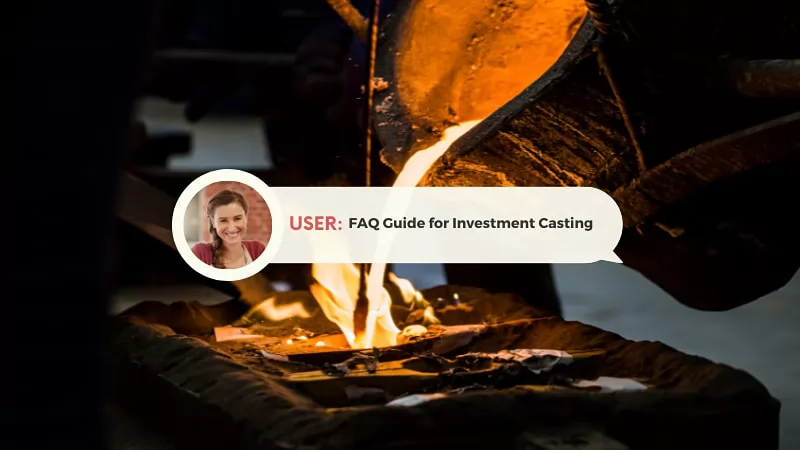
1. Why is It Called Investment Casting?
“investing” (surrounding) a pattern with refractory materials. Investment casting is often selected over other molding methods because the resulting castings present fine detail and excellent as-cast surface finishes.
2. Why Is Investment Casting Also Called Precision Casting?
The investment casting is also called precision casting because it have much better surface and higher accuracy than any other casting process. Especially for the silica sol casting process, the finished castings could reach the CT3 ~ CT5 in geometrical casting tolerance and CT4 ~ CT6 in dimensional casting tolerance. For the casings produced by investment casting process, there will be less or even no need to make the machining processes. To some extent, the investment casting could replace the rough machining process.
3. Why is Wax Used in Investment Casting?
Runner wax blends are used by investment casting companies when desiring exceptional mechanical strength and lower viscosity. This type of wax has a lower melting point than pattern waxes. So it will drain completely out of the ceramic mold during the dewaxing process without the need to use higher temperatures.
4. What As-cast Tolerances Can Investment Casting Achieve?
The investment casting process is capable of excellent repeatability. As-cast process capability of +/- three standard deviations when a single point location is repeatedly measured is typically +/- .003 to +/- .004 per inch. However, tolerance capability is largely influenced by part configuration. Symmetrical shapes with uniform wall sections will solidify with much less variation and distortion than non-symmetrical, non-uniform shapes.
5. In Which Investment Casting is Used For?
Investment casting is generally used for making complex-shaped components that require tighter tolerances, thinner walls and better surface finish than can be obtained with sand casting. The distinguishing feature of investment casting is the way the mould is made.
6. What Metals Can Be Used in Investment Casting
Lost Wax casting or Investment Casting can be integrated with a variety of metals and alloys such as carbon steel, stainless steel, aluminium, brass, bronze, copper, zinc and super-alloys such as Inconel and Hastelloy.
7. Is There an Advantage to Using Investment Casting for Replacement Parts?
Yes, cast replacement parts made from higher tensile alloys cost less and last longer, reducing your downtime for lost parts.
8. Is Investment Casting Expensive?
Generally, investment casting has an extensive labor and cost associated with the wax molds, which cause higher costs than forged parts or sand casting.
9. Are There Porosity and/or Shrinkage Defects with Investment Castings?
This depends on how well a metal casting facility make the gas out from the molten metal and how fast the parts solidify. As mentioned earlier, a properly built tree will allow porosity to be trapped in the tree, not the casting, and a high-heat ceramic shell allows for better cooling. Also, vacuum-investment cast components rid the molten metal of gassing defects as air is eliminated. Investment castings are used for many critical applications that require x-ray and must meet definite soundness criteria. The integrity of an investment casting can be far superior to parts produced by other methods.
10. How to Get the Best Value from Investment Castings
When you consider any process consider the total finished cost of the item. Be it forging, fabrication, machined or casting, it is your total cost that is often the key driver in your decision. Value added features such as consistent near net shape castings, superior as cast surface finish and appearance, cast part numbers, logos and other important branding considerations and are enhancements not easily included with other processes. Many parts that require miscellaneous machining operations or fabrication can be investment cast to full customer satisfaction. Often our parts become an integral part of a fabrication or machined assembly. Again, it is important for our customers to meet us and discuss your requirements to realize the potential value and savings.
11. What Lead Times Can I Expect when Ordering an Investment Casting?
With rapid prototype capabilities lead times can be very short such as three weeks from receipt of your drawing but a regular quote standard might be 6-12 weeks for tooling and sample castings and another 6-8 weeks for production.
If you even remotely think you may have an application or need for lost wax investment castings contact us today.
12. Where to Find a Professional Investment Casting Factory
Besser Foundry is a top custom investment casting manufacturer in China. We can supply various investment casting parts in steel, iron, nickel, etc.
If you have any needs for investment casting solutions, please contact us!
If you're looking for more investment casting information, check out the following articles:
Investment Casting Process Flow and Related Problems
Comparison of Investment Casting with Other Metal Casting Processes



